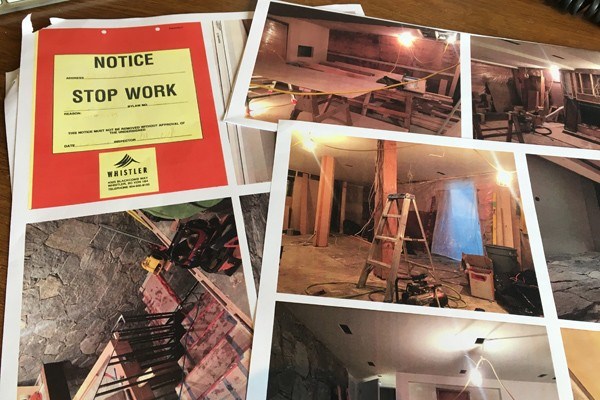A local construction company has had its business licence suspended for six weeks for not adhering to municipal building regulations around illegal spaces.
According to a lengthy report in the April 25 council package, DCC Construction and owner Darren Chalmers were issued a building permit in July of 2015 for an addition and the decommission of a suite in a house on Gondola Way. Chalmers, while agreeing to the suspension, disputes several facts in the municipal report.
The dispute arose when a site inspection found the formwork did not reflect submitted plans — Chalmers was asked to submit new plans.
The new plans included a fourth level, underground, which was rejected by the Resort Municipality of Whistler (RMOW) building department.
Revised plans were submitted in June of 2016, minus the fourth level, and approved by the RMOW.
But during a later inspection of the property — prompted by an anonymous complaint — inspectors found two levels of unauthorized underground development, constructed covertly based on the rejected plans, in essence making the home four storeys with two of those levels below ground level
"It's a pretty egregious set of circumstances which followed from those initial inspections, and that level of disregard for municipal policies, regulations and our bylaws — notwithstanding our great relationship with the vast majority of builders — we're not prepared to tolerate that," said Chief Administrative Officer Mike Furey in an April 24 phone call.
The maximum permitted gross floor area for a detached dwelling under RMOW bylaws is 465 square metres.
According to the council report, the house on Gondola Way, as it currently stands, is about 349.8 square metres over the maximum allowable density for an RS1 lot.
The report also alleges the home is four metres too tall and three storeys too high for its permits.
As the lot is perched on a hill, Chalmers had the slope to work with, Furey explained.
"So they're not subterranean, but they're down below... it's storeys on top of storeys into the side of a hill," he said.
Reached for comment by phone, Chalmers — who has owned his own Whistler construction company since 2009, and has lived here since 1988 — shared his thoughts on the suspension.
"It's completely ridiculous considering how many other red flags and projects like this are around the valley right now," he said. "I know of at least four or five right now."
The home in question was originally built in 1993, and the non-conforming space was already in place when the current owner purchased it, Chalmers said, adding that the renovation project was attempting to make the basement space legal.
"At the same time this permit was pulled, and this was why we thought we were going to be able to do this, there were three or four other permitted jobs... that had double basements because they were on such a steep incline that they were able to (exclude) and make legal basement space that was in their house," he said.
"And that's all this was, this was just trying to include and make legal basement space that should have been made legal."
The RMOW first moved to legitimize illegal spaces in 2012 by passing bylaws that allowed basement floor areas — or unregulated, uninspected "crawlspaces" — to be excluded from the total Gross Floor Area (GFA) of a home.
The idea was to remove uncertainty for homeowners and contractors, and ensure that crawlspaces got proper safety inspections.
This past December, in an attempt to rein in the increasing size of home builds, the RMOW passed an amendment to GFA exclusion regulations, making it so only those portions of basement below ground or in-ground qualify for the exclusion.
Chalmers said DCC entered into a settlement with the RMOW for the six-week suspension, but does not agree with or admit to many of the allegations contained in the report.
"I admitted to opening up the space so the owner could recover that space from 1993," Chalmers said. "Everything else is completely unproven and false in the report."
Chalmers maintains that nothing about the project is unsafe, and everything has been permitted and engineered under the BC Building Code, and said that a senior building inspector with the RMOW "basically gave us verbal approval to do all the work" before a staffing change in 2015. Chalmers argues that the changes to the GFA regulations have led to confusion around interpretations of reclaimed space.
Furey disagreed.
"He didn't have any approvals from the RMOW to do that," he said. "I can't speak to any verbal discussions, but he had no approvals... if he felt he had all those approvals I don't know why he was putting up false walls."
Furey said he doesn't believe this type of infraction is widespread, but the RMOW wants to send a message that it won't be tolerated.
"We're here to facilitate building and to work to see that people adhere to the bylaws and guidelines that council has established through the elected officials that the community has put in place over the many years, and for the most part I think that works really, really well," he said.
"I guess the message we're trying to send is we want to collaborate and we want to work with the builders and the homeowners in the community, (but) at the same time, when serious disrespectful disregard for the community and for other builders and for the safety of homeowners happens, we're going to take action on it."
The full report can be found in the April 25 council package, beginning on page 24: www.whistler.ca/municipal-gov/council/meeting-agendas-and-minutes.




